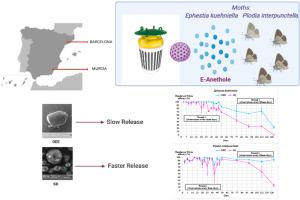Journal of Stored Products Research ( IF 2.7 ) Pub Date : 2021-08-07 , DOI: 10.1016/j.jspr.2021.101862 M.J. Pascual-Villalobos 1 , C. Castañé 2 , F. Martín 1 , M.D. López 3 , P. Guirao 4 , J. Riudavets 2

|
Pyrethroids are the insecticides most commonly used inside traps, and the lack of alternatives poses the risk of pests developing resistance. In this paper we present two (E)-anethole formulations (spray drying (SD) and oil emulsion entrapment (OEE) processes) that provide a controlled release of their bioactive ingredient in the vapour phase with insecticidal potential in funnel traps.
An experiment with the two pyralid moths Ephestia kuehniella Zeller and Plodia interpunctella Hübner was set up at two pilot stores in Spain for a four-month period. The microspheres (4 g of SD powder/trap or 6 g of OEE beads/trap) remained effective for 100 days, killing the moths by volatile activity. The efficacy values were within the interval of 70–100% for the first half of the experiment, with a decrease afterwards. The OEE beads performed better than did SD powder in the long run: over 80% efficacy for the whole experiment. The OEE process gives more loading capacity (19.7 g of (E)-anethole per 100 g of beads) and entrapment efficiency (28.6 g of (E)-anethole encapsulated per 100 g of (E)-anethole added) and is slower in releasing the product.
In a laboratory study for E. kuehniella, the LC50 was 58.2 mg/L for SD after 24 h exposure to vapours and 111.6 mg/L for OEE after 48 h exposure to vapours. Therefore, the SD powder provides a quicker release of the bioactive ingredient.
The results indicate that encapsulated (E)-anethole could be a promising insecticide for mass trapping, mating disruption and attract and kill strategies.
中文翻译:

(E)-茴香脑微球作为漏斗陷阱中的替代杀虫剂
拟除虫菊酯是陷阱内最常用的杀虫剂,缺乏替代品会导致害虫产生抗药性的风险。在本文中,我们介绍了两种(E)-茴香脑制剂(喷雾干燥 (SD) 和油乳剂截留 (OEE) 工艺),它们可在汽相中控制释放其生物活性成分,并在漏斗陷阱中具有杀虫潜力。
在西班牙的两家试点商店对两种螟蛾Ephestia kuehniella Zeller 和Plodia interpunctella Hübner 进行了为期四个月的实验。微球(4 克 SD 粉末/陷阱或 6 克 OEE 珠/陷阱)保持有效 100 天,通过挥发性活性杀死飞蛾。实验前半部分的功效值在 70-100% 的区间内,之后下降。从长远来看,OEE 微珠的性能优于 SD 粉末:整个实验的功效超过 80%。OEE 工艺提供更高的负载能力(每 100 克珠粒19.7 克(E)-茴香脑)和截留效率(每 100 克(E)-封装28.6 克(E)-茴香脑)添加茴香脑)并且释放产品的速度较慢。
在E. kuehniella的实验室研究中,暴露于蒸气 24 小时后 SD 的 LC50 为 58.2 mg/L,暴露于蒸气 48 小时后 OEE 的 LC50 为 111.6 mg/L。因此,SD 粉末可以更快地释放生物活性成分。
结果表明,封装的(E)-茴香脑可能是一种很有前途的杀虫剂,可用于大规模诱捕、干扰交配以及引诱和杀灭策略。











































 京公网安备 11010802027423号
京公网安备 11010802027423号